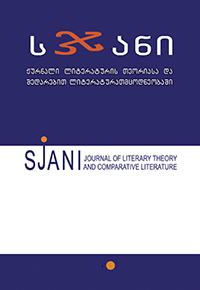ზაუმი" - ლინგვისტური ექსპერიმენტიდან არტტენდენციისაკენ
Zaum - from Lomguistic Experimentsto art-Trend
Author(s): Tamar PaichadzeSubject(s): Poetry, Sociology of Art
Published by: ლიტერატურის ინსტიტუტის გამომცემლობა
Keywords: Poetry; futurism; Zaum; Linguistics; Artistic model;
Summary/Abstract: There are many cases in literature history when not the creative means of perception and expression, but certain linguistic formats have become features of a creative method. Zaum must be considered as one of such precedents, which has become subject to differing (I would even say, contradictory) assessment by literature scientists. Zaum is a clear demonstration of the search for expression forms by a creator; of the extraordinary and individualism; therefore, it is natural that its signs and impulses are quite often found in different literary texts. Zaum was cultivated in the depths of Russian futurism. Zaum – “the new rule of uniting words” became the basis for certain revolutionary, avant-gardism and leftwing aesthetics in literature. It questioned the existing “rules of expressing ideas through words” and to certain extent destroyed the meanings of words; although, typically Russian “zaumniks” (futurists) recognized that their inspiration for such searches was also founding the previous period and genre texts, such as, folklore, oriental literature and finally the symbolist texts – it can be said that Zaum formation started right from that period, not only as culturological method, but also as linguistic trend. Zaum texts became the profile tool of expression characterizing futurist literature.Firstly, right in Russian poetry, Russian futurists of the first generation accepted Zaum worldview as the main method for their creative views. Thus, Zaum, as worldview or method was not so widely used in Italian futuristic texts, as in Russian ones. Russian futurists did not only use, but also deepened and further developed the ideas of search for words, denial of the classical, fetishism of own novelties, characterizing Italian futurism.As result, at the next stage of development of European avant-gardism, Zaum form of expression became a feature of Dadaist literature. Tbilisi Zaum is part of the given history too;It is a well-known fact in the history of Russian literature that Russian futurism continued in Georgia. After 26 May 1918 Tbilisi changed, Georgia separated from Bolshevik Russia and declared state independence, which meant not only the existence of the administrative center, it would become the center of culture. Russian writers and artists that had escaped from the Red Revolution appeared in Tbilisi. The abovementioned political factorhas conditioned the establishment of a “Method Writing” form – a literatural leftism for Georgian creative reality.From 1918, famous futurists arrived in Tbilisi: Aleksei Kruchenkh, Igor Terentyev, Vasil Kamensky, Sergei Sudikin and Zigmund Walishevsky, From this time Ilia and Kirill Zdanevichs returned to Tbilisi with futuristic creative experience, The Georgian society was quite prepared for this fact, even though the futuristicmovement in Georgian writings did not exist at that time, its principles and history waswell known. From now on, Tbilisi became one of the most important hubs of the avant-gardemovement. It became not only a physical but spiritual shelter for the artists, who fled fromRussia to escape the destruction, political cataclysms and hunger. The intellectuals thatescaped from Russia were heartily greeted by Georgian modernist writers. Thus, it can be said that in the Georgian space the Russian Futurism has acquired an important nature. He freed from the cult of the force, aggression, ignorance of moral and ethical values: futurism in Tiflis was less radical and artistic and literary forms-oriented, in spite of lectures and other public statements, the public interest and the unusual nature,there was no confrontations. Presentation of Georgian Futurism began from the 20ies, the dates of its announcement were declared as a beginning of new census in the Georgian poetry by the representatives of the futurist group. At the moment of appearance of Zaum artefacts, Georgian futurism was comparedto earthquake – principles of linguistic experiments, constructivism, Dadaism and futurism were united under one name. Despite certain linkage of Georgian analogues with Russian metaphysical Zaum, Georgian Zaum contexts are still characterized with different, characteristic signs; denial of the “super-syntactic Zaum” and clearly intuitive and associative connection of phraseological and phonetic novelties presented in creative texts, with the topic and idea of the text itself. The history of Georgian avant-garde art coincided with the colonial regime of the Soviet Union. In this period, the futuristic texts created and books published were anextraordinary, maximalist or eccentric phenomenon. The phenomenon of this event is revealed in complexity of social, political, aesthetic and moral aspects synthesis that is not completely explained. However, the Georgian Futuristic School was not being safe from epochal social influences – the idea of revolution was also announced by the Georgian futurists as the challenge for their renewed views. Like other artists in front of the totalitarian regime, Georgian futurists also paid tribute, motivated by a good idea of revolutionism they became the victims of revolution, some of them physically and some of them personally creatively. Since the 30's, at the stage of great political repressions, their literary apogee was forgotten as a result of ideological pressure. Thus, futurism has not been the only historical or epigenous event in the Caucasus, its literary mentality and genetic origin have become more recognizable since its completion, as futuristic forms of rhythmic-musical perfection, artistic-formal systematization in literary narratives have appeared in further periods of writing and generally reflected in the literary life of the twentieth century and made a psychological breakthrough of the history of art.
Journal: სჯანი
- Issue Year: 2017
- Issue No: 18
- Page Range: 151-168
- Page Count: 18
- Language: Georgian

